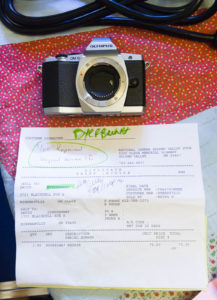My primary camera came back as “beyond service life” and hence unrepairable. Even the guy at the camera store was surprised, he had to look up when it was released (it was announced in February of 2012).

Meanwhile, I could easily get a Leica M3 (made around the same time I as) or a Nikon F (about 5 years newer than the Leica) repaired. Of course those two are special cases, they’re both regarded as important classics. And, being old-school completely mechanical cameras, the parts they need can be manufactured pretty easily today, without any help from the original manufacturers.
This was my only video camera and my primary still camera (though the D700 still does a much better job on roller derby and in dark bars and music circles).
I’ve been playing around in my head with where to take the camera collection from here, given that both sides (this Micro Four Thirds body and the lenses for it, and my Nikon D700 and those lenses) are getting old by modern standards (the D700 is even older, having been released in July of 2008; I’ve already had one autofocus system repair). This is rather financially constrained, among other things. (Some of the Nikon lenses I’m using I bought in 1981, and they still work fine, and still could be repaired though perhaps not by Nikon themselves.)
I think it’s time to abandon flappy mirrors; they’re a silly idea in digital cameras. However, full-frame sensors do seriously better in low light than smaller ones (no smaller sensor has yet matched the specs of my 2008 D700 full-frame sensor), and DSLRs have better auto-focus for tracking and fast action than any mirrorless (except possibly maybe the hugely expensive top-of-the-line Sony A9, which doesn’t take any of my lenses). And there aren’t many full-frame mirrorless lines; there’s the Sony, and a Leica (which makes the Sony look cheap). But the state of the art in sensors and electronics is advancing constantly; while no smaller sensor has caught up to my D700 yet, they’re close, and no doubt will catch up soon. Of course today’s full-frame sensors are five generations (or some such) better, and still well ahead, but at some point something becomes “good enough” and it’s not worth paying hugely for small improvements for most kinds of photography. Nikon is allegedly about to release their own mirrorless full-frame system, but how well it will work with old Nikon lenses is anybodies guess. For that matter how well it will work at all is still up in the air.
With financial constraints, concentrating back into one system is nearly certainly the way to go, and for cost and flexibility the Micro Four Thirds seems to be the best choice starting from where I am.
Have to think about it; I wonder what I’ll actually do—and when?